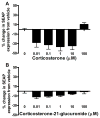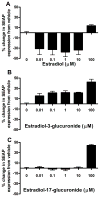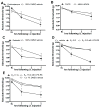Select steroid hormone glucuronide metabolites can cause toll-like receptor 4 activation and enhanced pain
- PMID: 25218902
- PMCID: PMC4275344
- DOI: 10.1016/j.bbi.2014.09.004
Select steroid hormone glucuronide metabolites can cause toll-like receptor 4 activation and enhanced pain
Abstract
We have recently shown that several classes of glucuronide metabolites, including the morphine metabolite morphine-3-glucuronide and the ethanol metabolite ethyl glucuronide, cause toll like receptor 4 (TLR4)-dependent signaling in vitro and enhanced pain in vivo. Steroid hormones, including estrogens and corticosterone, are also metabolized through glucuronidation. Here we demonstrate that in silico docking predicts that corticosterone, corticosterone-21-glucuronide, estradiol, estradiol-3-glucuronide and estradiol-17-glucuronide all dock with the MD-2 component of the TLR4 receptor complex. In addition to each docking with MD-2, the docking of each was altered by pre-docking with (+)-naloxone, a TLR4 signaling inhibitor. As agonist versus antagonist activity cannot be determined from these in silico interactions, an in vitro study was undertaken to clarify which of these compounds can act in an agonist fashion. Studies using a cell line transfected with TLR4, necessary co-signaling molecules, and a reporter gene revealed that only estradiol-3-glucuronide and estradiol-17-glucuronide increased reporter gene product, indicative of TLR4 agonism. Finally, in in vivo studies, each of the 5 drugs was injected intrathecally at equimolar doses. In keeping with the in vitro results, only estradiol-3-glucuronide and estradiol-17-glucuronide caused enhanced pain. For both compounds, pain enhancement was blocked by the TLR4 antagonist lipopolysaccharide from Rhodobacter sphaeroides, evidence for the involvement in TLR4 in the resultant pain enhancement. These findings have implications for several chronic pain conditions, including migraine and temporomandibular joint disorder, in which pain episodes are more likely in cycling females when estradiol is decreasing and estradiol metabolites are at their highest.
Keywords: (+)-Naloxone; Corticosterone; Corticosterone-21-glucuronide; Estradiol; Estradiol-17-glucuronide; Estradiol-3-glucuronide; TLR4.
Copyright © 2014 Elsevier Inc. All rights reserved.
Figures




Similar articles
-
Glucuronic acid and the ethanol metabolite ethyl-glucuronide cause toll-like receptor 4 activation and enhanced pain.Brain Behav Immun. 2013 May;30:24-32. doi: 10.1016/j.bbi.2013.01.005. Epub 2013 Jan 21. Brain Behav Immun. 2013. PMID: 23348028 Free PMC article.
-
Evidence that intrathecal morphine-3-glucuronide may cause pain enhancement via toll-like receptor 4/MD-2 and interleukin-1beta.Neuroscience. 2010 Jan 20;165(2):569-83. doi: 10.1016/j.neuroscience.2009.10.011. Neuroscience. 2010. PMID: 19833175 Free PMC article.
-
Evidence that opioids may have toll-like receptor 4 and MD-2 effects.Brain Behav Immun. 2010 Jan;24(1):83-95. doi: 10.1016/j.bbi.2009.08.004. Epub 2009 Aug 11. Brain Behav Immun. 2010. PMID: 19679181 Free PMC article.
-
Toll-Like Receptor 4 (TLR4)/Opioid Receptor Pathway Crosstalk and Impact on Opioid Analgesia, Immune Function, and Gastrointestinal Motility.Front Immunol. 2020 Jul 8;11:1455. doi: 10.3389/fimmu.2020.01455. eCollection 2020. Front Immunol. 2020. PMID: 32733481 Free PMC article. Review.
-
Acyl glucuronide metabolites: Implications for drug safety assessment.Toxicol Lett. 2017 Apr 15;272:1-7. doi: 10.1016/j.toxlet.2017.03.003. Epub 2017 Mar 7. Toxicol Lett. 2017. PMID: 28286018 Review.
Cited by
-
A neural circuit for sex-dependent conditioned pain hypersensitivity in mice.Nat Commun. 2025 Apr 17;16(1):3639. doi: 10.1038/s41467-025-58851-x. Nat Commun. 2025. PMID: 40240334 Free PMC article.
-
Opioid-induced central immune signaling: implications for opioid analgesia.Headache. 2015 Apr;55(4):475-89. doi: 10.1111/head.12552. Epub 2015 Mar 31. Headache. 2015. PMID: 25833219 Free PMC article. Review.
-
Roads Less Traveled: Sexual Dimorphism and Mast Cell Contributions to Migraine Pathology.Front Immunol. 2016 Apr 19;7:140. doi: 10.3389/fimmu.2016.00140. eCollection 2016. Front Immunol. 2016. PMID: 27148260 Free PMC article. Review.
-
Morphine-3-Glucuronide, Physiology and Behavior.Front Mol Neurosci. 2022 May 12;15:882443. doi: 10.3389/fnmol.2022.882443. eCollection 2022. Front Mol Neurosci. 2022. PMID: 35645730 Free PMC article. Review.
-
A bioinformatics investigation into the pharmacological mechanisms of the effect of Fufang Danshen on pain based on methodologies of network pharmacology.Sci Rep. 2019 Apr 11;9(1):5913. doi: 10.1038/s41598-019-40694-4. Sci Rep. 2019. PMID: 30976033 Free PMC article.
References
-
- Barnes PJ. Mechanisms and resistance in glucocorticoid control of inflammation. J Steroid Biochem Mol Biol. 2010;120:76–85. - PubMed
-
- Belanger A, Candas B, Dupont A, Cusan L, Diamond P, Gomez JL, Labrie F. Changes in serum concentrations of conjugated and unconjugated steroids in 40- to 80-year-old men. J Clin Endocrinol Metab. 1994;79:1086–1090. - PubMed
-
- Blyth FM, March LM, Brnabic AJ, Jorm LR, Williamson M, Cousins MJ. Chronic pain in Australia: a prevalence study. Pain. 2001;89:127–134. - PubMed
-
- Chaplan SR, Bach FW, Pogrel JW, Chung JM, Yaksh TL. Quantitative assessment of tactile allodynia in the rat paw. J Neurosci Methods. 1994;53:55–63. - PubMed
-
- Ciuffreda P, Casati S, De Mieri M, Ferraboschi P. Corticosteroids 21-glucuronides: synthesis and complete characterization by (1)H and (13)C NMR. Steroids. 2009;74:870–875. - PubMed
Publication types
MeSH terms
Substances
Grants and funding
LinkOut - more resources
Full Text Sources
Other Literature Sources
Medical
Research Materials

